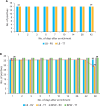Effect of Selective Enrichment Storage Temperature and Duration Time on the Detection of Salmonella in Food
- PMID: 38407384
- PMCID: PMC11066602
- DOI: 10.1093/jaoacint/qsae014
Effect of Selective Enrichment Storage Temperature and Duration Time on the Detection of Salmonella in Food
Abstract
Background: For pathogen detection in food, there are occasions where samples cannot be processed immediately after selective enrichment or need to be reexamined days or weeks later for confirmation or retest.
Objective: This study aimed to investigate the effect of different prolonged period of storage of selective enrichments of food at 4 ± 2°C and room temperature (20-22°C) on the detection and isolation of Salmonella.
Method: This study included two experiments involving 34 types of foods to compare the effect of 4 ± 2°C and room temperature storage on the detection of Salmonella in 204 selective enrichments (Rappaport-Vassiliadis [RV] and Tetrathionate [TT] broths) during a 42-day storage (Experiment I); and to monitor the survival of Salmonella in 300 selective enrichments (RV and TT) with different pre-enrichment broths (Lactose broth [LB] or Buffered peptone water broth [BPW]), stored at 4°C for 60 days (Experiment II). All the samples were subjected to Salmonella analysis following the FDA BAM method.
Results: During multiple samplings, the positive detection rate for Salmonella remained consistent through Day 42 after selective enrichment, irrespective of Salmonella serotype, storage temperature, pre-enrichment broth, or selective enrichment broth in both Experiment I and II. However, on Day 60 sampling in Experiment II, seven previously positive results turned to negatives. These data indicated that storage of RV and TT enrichments at 4 ± 2°C or room temperature for up to 42 days after selective enrichment did not compromise the detection of Salmonella in the tested food categories, regardless of Salmonella serotypes and the broths used for pre-enrichment and selective enrichment.
Conclusions: At least for the food types studied in this experiment, the recovery of Salmonella from selective enrichments could be postponed for a limited period of time (e.g., <42 days) if needed without adversely affecting the test results. However, the delayed analysis of TT and RV enrichments does pose a risk of reduced detection sensitivity, as evidenced by the seven negative results on Day 60 compared to previous positives. We do not recommend or endorse delaying the analysis of TT and RV enrichments.
Highlights: In the food matrixes investigated in this experiment, the plating and isolation of Salmonella from selective TT and RV enrichments stored at 4 ± 2°C or room temperature could be deferred for a period (up to 42 days) without any negative effect on the test results, if necessary.
© The Author(s) 2024. Published by Oxford University Press on behalf of AOAC INTERNATIONAL.
Conflict of interest statement
The authors declare no conflict of interest.
Figures



Similar articles
-
Early Recovery of Salmonella from Food Using a 6-Hour Non-selective Pre-enrichment and Reformulation of Tetrathionate Broth.Front Microbiol. 2016 Dec 27;7:2103. doi: 10.3389/fmicb.2016.02103. eCollection 2016. Front Microbiol. 2016. PMID: 28082968 Free PMC article.
-
Relative effectiveness of selenite cystine broth, tetrathionate broth, and Rappaport-Vassiliadis medium for the recovery of Salmonella from raw flesh and other highly contaminated foods: precollaborative study.J AOAC Int. 1995 Mar-Apr;78(2):375-80. J AOAC Int. 1995. PMID: 7756852
-
Relative effectiveness of selenite cystine broth, tetrathionate broth, and rappaport-vassiliadis medium for recovery of Salmonella spp. from raw flesh, highly contaminated foods, and poultry feed: collaborative study.J AOAC Int. 1996 Nov-Dec;79(6):1307-23. J AOAC Int. 1996. PMID: 8946709
-
Selective pre-enrichment method to lessen time needed to recover Salmonella from commercial poultry processing samples.Food Microbiol. 2021 Oct;99:103818. doi: 10.1016/j.fm.2021.103818. Epub 2021 Apr 24. Food Microbiol. 2021. PMID: 34119103
-
Salmonella in foods: new enrichment procedure for TECRA Salmonella Visual Immunoassay using a single rv(R10) only, TT only, or dual rv(R10) and TT selective enrichment broths (AOAC official method 998.09): collaborative study.J AOAC Int. 2003 Jul-Aug;86(4):775-90. J AOAC Int. 2003. PMID: 14509439
References
-
- World Health Organization (WHO) (2023) Salmonella (non-typhoidal), https://www.who.int/news-room/fact-sheets/detail/salmonella-(non-typhoidal) (accessed January 20, 2023)
-
- Callejón R.M., Rodríguez-Naranjo M.I., Ubeda C., Hornedo-Ortega R., Garcia-Parrilla M.C., Troncoso A.M. (2015) Foodborne Pathog. Dis. 12, 32–38 - PubMed
-
- Todar K. (2006) Todar’s online textbook of bacteriology: Salmonella and Salmonellosis, http://textbookofbacteriology.net/salmonella.html (accessed January 26, 2023)
MeSH terms
Substances
Grants and funding
LinkOut - more resources
Full Text Sources
Miscellaneous

